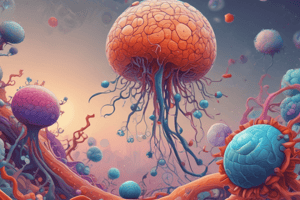Podcast
Questions and Answers
What physiological mechanism helps humans regulate body temperature?
What physiological mechanism helps humans regulate body temperature?
- Gas exchange
- Homeostasis (correct)
- Inflammation
- Photosynthesis
Which components are crucial for the transport of oxygen and nutrients in the human body?
Which components are crucial for the transport of oxygen and nutrients in the human body?
- Immune system
- Nervous system
- Respiratory system
- Circulatory system (correct)
Which factor can lead to a disease due to genetic defects?
Which factor can lead to a disease due to genetic defects?
- Environmental toxins
- Inherited mutations (correct)
- Infection by bacteria
- Nutritional deficiencies
What is the primary function of the immune system?
What is the primary function of the immune system?
What specialized function do roots, stems, and leaves perform in plants?
What specialized function do roots, stems, and leaves perform in plants?
What is the primary function of cellular respiration?
What is the primary function of cellular respiration?
Which of the following structures is found in eukaryotic cells but not in prokaryotic cells?
Which of the following structures is found in eukaryotic cells but not in prokaryotic cells?
What occurs during protein synthesis?
What occurs during protein synthesis?
According to Mendel's principle of segregation, each gamete receives how many alleles for each gene?
According to Mendel's principle of segregation, each gamete receives how many alleles for each gene?
Which domain includes organisms that are primarily single-celled and lack a nucleus?
Which domain includes organisms that are primarily single-celled and lack a nucleus?
What role do mutations play in genetics?
What role do mutations play in genetics?
Which process describes how energy and nutrients flow through an ecosystem?
Which process describes how energy and nutrients flow through an ecosystem?
What is a characteristic of competition in ecosystems?
What is a characteristic of competition in ecosystems?
Flashcards
Homeostasis
Homeostasis
The process by which organisms maintain a stable internal environment despite external changes.
Circulatory system
Circulatory system
The system that transports oxygen, nutrients, and waste products throughout the body.
Immune system
Immune system
The body's defense system against pathogens, harmful substances, and diseases.
Photosynthesis
Photosynthesis
Signup and view all the flashcards
Plant reproduction
Plant reproduction
Signup and view all the flashcards
Cells
Cells
Signup and view all the flashcards
Cellular Respiration
Cellular Respiration
Signup and view all the flashcards
DNA Replication
DNA Replication
Signup and view all the flashcards
Protein Synthesis
Protein Synthesis
Signup and view all the flashcards
Mitosis
Mitosis
Signup and view all the flashcards
Meiosis
Meiosis
Signup and view all the flashcards
Evolution
Evolution
Signup and view all the flashcards
Study Notes
Cell Structure and Function
- Cells are the basic units of life, varying greatly in shape and size.
- All cells share fundamental features: a plasma membrane, cytoplasm, and genetic material (DNA).
- Prokaryotic cells (bacteria and archaea) lack a nucleus and membrane-bound organelles.
- Eukaryotic cells (animals, plants, fungi, and protists) possess a nucleus and various membrane-bound organelles, including mitochondria, endoplasmic reticulum, Golgi apparatus, and chloroplasts (in plant cells).
Cellular Processes
- Cellular respiration breaks down glucose to produce ATP, the cell's primary energy source.
- Photosynthesis, unique to plant cells, converts light energy into glucose.
- DNA replication ensures accurate genetic material duplication during cell division.
- Protein synthesis involves transcription (DNA to RNA) and translation (RNA to protein).
- Cell division (mitosis and meiosis) is crucial for growth, repair, and reproduction. Mitosis creates identical daughter cells, while meiosis forms genetically diverse gametes.
Principles of Inheritance
- Genes are DNA segments directing protein production.
- Alleles are different forms of a gene.
- The principle of segregation dictates each gamete receives one allele per gene.
- The principle of independent assortment means alleles for different genes segregate independently.
- Mendel's laws explain trait inheritance from parents to offspring.
- Mutations are DNA sequence changes causing trait variations.
Diversity of Life
- Organisms are classified into three domains: Bacteria, Archaea, and Eukarya.
- Each domain encompasses various kingdoms.
- Biological diversity is the variety of life forms across all levels, from genes to ecosystems.
- Evolution is species change through time, driven by natural selection.
Ecology
- Organisms interact intricately with their environments.
- Ecosystems comprise biotic (living) and abiotic (non-living) factors.
- Food webs illustrate energy and nutrient flow in ecosystems.
- Biodiversity is life variety within a specific region or ecosystem.
- Predation, competition, and symbiosis shape ecosystems.
Physiology
- Organisms maintain homeostasis through physiological processes.
- Examples include regulating human body temperature, blood pressure, and pH.
- The human circulatory system transports oxygen and nutrients.
- The nervous system enables communication and coordination.
- The respiratory system facilitates gas exchange.
Mechanisms of Disease
- Disease arises from pathogens (bacteria, viruses, fungi), genetic defects, and environmental factors.
- The immune system defends the body against pathogens.
- Injury response involves inflammation and repair processes.
Plant Biology
- Plants perform essential functions, including photosynthesis and maintaining the environment.
- Root, stem, and leaf structures perform specialized roles.
- Plant reproduction involves flower, seed, and fruit formation.
Studying That Suits You
Use AI to generate personalized quizzes and flashcards to suit your learning preferences.




